|
Phasing out azodyes with indigo
cultivation
By Shaukat Ali Bhambhro
Dyes which contain free heavy metal ions are classified as
azo-dyes. Under chemical reaction, these dyes produce amino
acid groups which causes cancer and allergies. Neither the
common people are aware of the harful effects of the azodyes,
nor the government takes any measures to put a ban on the use
of these poisonous dyes.
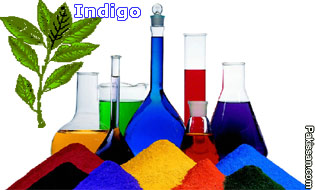 Azodyes
are used in the textile, paper manufacturing, pharmaceuticals,
food industries, research laboratories, etc. Repotedly,
azodyes account for about 70 per cent of the dyes produced
world wide. Azodyes
are used in the textile, paper manufacturing, pharmaceuticals,
food industries, research laboratories, etc. Repotedly,
azodyes account for about 70 per cent of the dyes produced
world wide.
Extensive research and experiments have indicated that cancer
can to be caused by these dyes in the buccal cavity, pharynx,
ovaries, breast, brain, salivary glands and cervix of the
uterus. Because of this apprehension, Germany, Netherlands,
Austria and Norway have announced a ban on manufacture,
import, export and sale of textile or products containing
azodyes that could come into contact with human skin for a
long period. Besides, the European Parliament and the Council
of the European Union, in a bid to protect the consumer from
the cancer risk, have reportedly issued a directive during the
year 2002 restricting the marketing and use of certain
dangerous substances, and preparation generally known as
azocolourants.
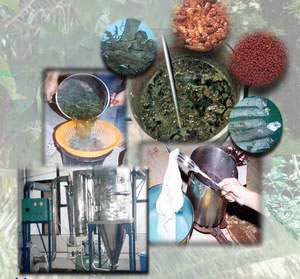 Reportedly,
the European Commission has also adopted measures to strict
adherence to the standards laid down, and any deviation on the
part of an import consignment after going through lab test
could led to a ban. Accordingly, following these measures
adopted by USA an European Union Pakistani textile and leather
export, which constitutes around 70 per cent of total export,
is likely to sustain a severe blow. Reportedly,
the European Commission has also adopted measures to strict
adherence to the standards laid down, and any deviation on the
part of an import consignment after going through lab test
could led to a ban. Accordingly, following these measures
adopted by USA an European Union Pakistani textile and leather
export, which constitutes around 70 per cent of total export,
is likely to sustain a severe blow.
But the irony of the fact is that both government and private
sector concerned have not taken these potent threat seriously
hitherto More over, under WTO's sanitary and phytosanitary
regime border control measures necessary to protect human,
animal and plant life or health have become inevitable while
dealing with the trade among the nations. In this respect it
would be pertinent to mention here that Bangladesh, whose
textile and leather export sectors are a major source of
foreign exchange earning, has embarked upon indigo farming
aimed at phasing out of this deadly material [azodyes] with
the help and technical assistance of some foreign countries.
Reportedly, in a rewarding reversal of history, marked by
sordid chapter in British colonial rule in India, farmers in
Bangladesh have resumed the cultivation of indigo - the source
of the famous blue dyes.
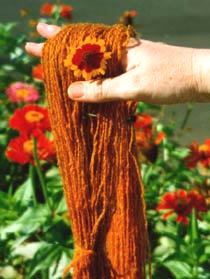 The
so-called "Blue Revolution" is taking place some 150 years
after the historic "Blue Mutiny" by the indigo farmers of the
then undivided Bengal (now part of it Bangladesh, and the
province of west Bengal in India) against its forced farming.
Ironically, the indigo revival is being funded by westerners -
the Mannonite Central Committee (MCC) and an American
non-governmental organization which says its project is aimed
at amending a tented past. The
so-called "Blue Revolution" is taking place some 150 years
after the historic "Blue Mutiny" by the indigo farmers of the
then undivided Bengal (now part of it Bangladesh, and the
province of west Bengal in India) against its forced farming.
Ironically, the indigo revival is being funded by westerners -
the Mannonite Central Committee (MCC) and an American
non-governmental organization which says its project is aimed
at amending a tented past.
It may be mention here that more then a century later, the
Bangladesh government, noticing the increasing global interest
in natural dyes, began researching the abandoned "Neel
Kuthis", or the indigo extraction centres, in different part
of the country.
The research results were put to practice under a pilot
programme to cultivate indigo on a single acre on land in
Dhaka in 1983. The experiment turned outto be a success,
sparking further project involving the hill tribes from
Madhopur in the Tangail District in central Bangladesh.
However, commercial production and marketing began at the
start of 2001. Reportedly, indigo dyes products are presently
exported to Italy, America, and once again Britain.
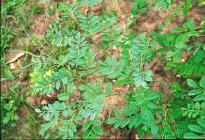 Under
the scheme farmers are supplied seeds - procured from India.
According to Iqbal Hussain of the MCC, who is in charge of
indigo cultivation at Madhopur, after the harvest project
authorities buy indigo leaves to prepare the dyes. Farmers are
paid Taka 6000 per bigha (0.13 hectare) of leaves which is
nearly double the amount they use to get for farming other
crops. Under
the scheme farmers are supplied seeds - procured from India.
According to Iqbal Hussain of the MCC, who is in charge of
indigo cultivation at Madhopur, after the harvest project
authorities buy indigo leaves to prepare the dyes. Farmers are
paid Taka 6000 per bigha (0.13 hectare) of leaves which is
nearly double the amount they use to get for farming other
crops.
However, so far as cultivation of indigo in Pakistan is
concerned presently it is cultivated on small scale in
Khairpur and Naushero Feroze Districts of the upper Sindh.
Indigo leaves are used to prepare hair colour. In the local
market the leaves are usually sold at a price of Rs100 per kg.
Under the climatic condition of upper Sindh indigo cultivation
is undertaken during February-March.
The seed is drill-sown at the rate of 10-12kg per acre.
According to the growers, who used to undertake cultivation of
this crop at Kot Diji in District Khairpur, crop was found
giving good foliage even with a half bag of DAP and one bag of
Urea fertilizer per acre under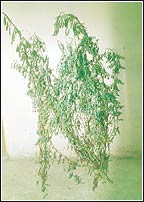 normal irrigation water. Two cutti are obtained first in
July-August and second in September.
normal irrigation water. Two cutti are obtained first in
July-August and second in September.
Suggestions:
To ensure un interrupted export of our textile and leather
products especially to European counties and USA it is
imperative that phasing out of azodyes with natural dyes is
taken into account on priority basis. Since range of colours
based on indigo is extensive and among natural dyes indigo has
special qualities it is suggested that cultivation of indigo
in the country particularly in Sindh is given official
patronage like Bangladesh.
The writer agriwatch@hotmail.com is an entomologist.
The Dawn
|
Pakissan.com;
|